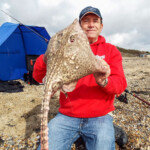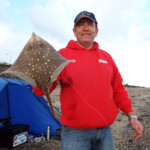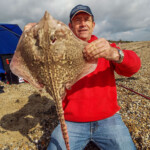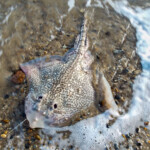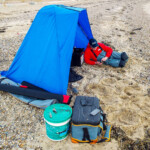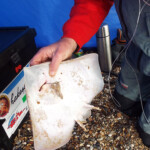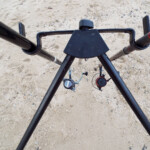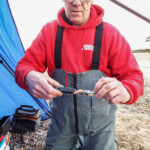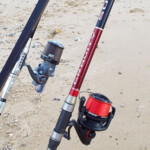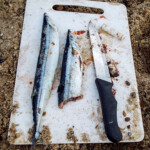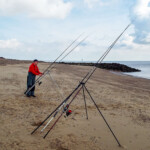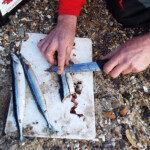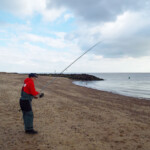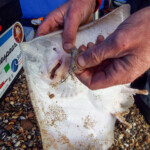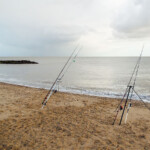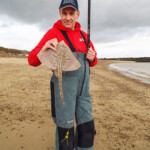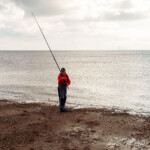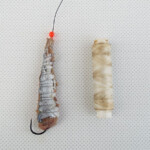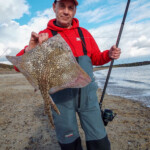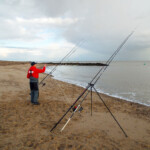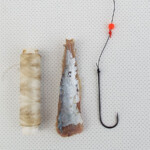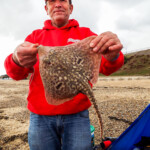It wasn’t that many years ago when to catch a thornback ray from any of the Essex beaches would be classed as a triumph of the first degree, but nowadays not catching one is slightly more difficult! Here John Popplewell takes us down to his local beach to target these popular fish.
Until recently, I would always categorise certain fish on the East coast as seasonal. This is how it went. Spring in my book always started mid-March and was heralded with a run of lesser spotted dogfish followed in early April by the first of the early Essex thornback ray and by no means were they easy to catch.

Joe spots a bite
Clacton Up First
Clacton Pier always saw a few of them first, tracked two weeks later by a run of Essex thornback rays on Walton Pier and the only beach that they ever appeared on was the wild St Osyth shoreline. The Essex side of the River Stour at Wrabness, four miles from the sea, was my favourite haunt for the first of the early ray on the Easter weekend.
The whiting appeared the first week of September and were gone by Christmas, now they are with us all year. I am slightly diversifying from the main topic, but I am just giving you a feel for our ever changing seasons.
Year-Round Rays
We can now catch rays throughout the year, and I set myself a challenge last year, to catch at least one thornback ray every month of the year, which has never been known before. And I finally came through with full honours. January was the pinnacle when I landed seven thornies to 9lbs in one session, all on squid baits. And losing another three on the same tide.
I remember fishing years in the 1980s when I didn’t catch a ray all season. How times have changed and let’s savour every trip because we all know sea fishing can be very fickle as we have learnt with our precious cod stocks. Here today and gone tomorrow, let’s make the most of it.
I am also great believer that when there is a void in the sea life, for example the lack of cod, it will be filled with another opportunistic species. The past couple of years that seems to be our trusty Essex thornback ray. And boy, are we seeing some great ray catches from our coast, including Holland on Sea. I really cannot remember a more memorable time in recent years.
Holland on Sea Changes
I have had some humdinger sessions during the last couple of years, culminating with an epic this year. I had a session on the Holland on Sea beaches with old school mate Mark Oxley and we landed 15 plus rays in three hours and I was only using one rod. The “plus” is putting it mildly as I think we caught at least ten each.

The rays are on it
The Holland beaches bear no resemblance to how they were a few years ago. Gone are the wooden breakwaters and low beaches where we would have to walk up and down over the sand with the tide.
The new multi-million-pound sea defence, and I’m talking 50 million pounds, has seen tonnes of sand pumped on to the depleted beaches. Massive Norwegian granite rocks have been shipped in to make fish tail groynes to hold everything in place. The enormous investment is proving its worth and I can tell you that it is all working very well.

A well marked Essex thornback ray
Now it really is easy fishing, no need to chasing or being chased by the tide, just set your base up and fish.
What I will say is that we anglers are not the only people that use these newly established beaches. They are for everyone, dog walkers, holiday makers and swimmers alike. I tend to keep my baited spare rigs in a closed bucket, this alleviates any potential confrontation with our little furry doggy friends and their owners.
Essex Thornback Feeding Time
Thornback rays tend to feed on the slacker part of the tides so the best time is usually the most of a flood tide and the last three hours of the ebb, too much run in the tide and the rays hug the bottom until the current has eased enough for their flat bodies to cruise about hunting for their next tasty morsel.
I normally use single hook pulley rigs with 2/0 Kamasan B940 hooks that fit the bill very well. I opt for a single hook rather than a pennel setup as the thornbacks tend to gorge the bait. One hook is much easier to remove. The B940 model is also a strong hook and can withstand catching more than one ray in a session.
Cunning Baiting Up Plan
You would think the bait would just end up in a blob on the single hook when cast. But a way round it is to use power gum as a stop knot on the hook trace line with a bead above it. Have this an inch or so above the hook. When baiting with your bluey, herring or squid strips aim for it to reach the bead.

Ready to bait a Kamasan B940
Wrap bait elastic around the bait and continue up and take some turns round the bead and power gum knot. This will hold the bait up the line when casting and present it perfectly to any interested fish.
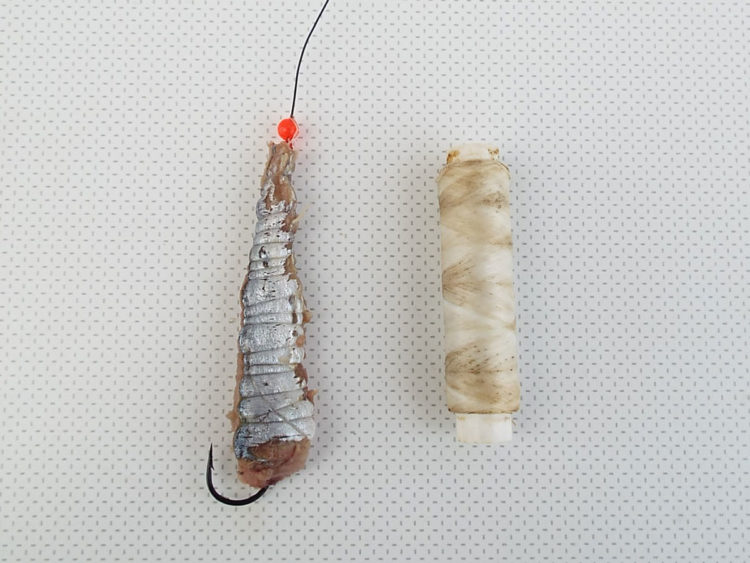
Bait wrapped with elastic round bead and stop knot
If the hook is too deeply swallowed it’s always best to just cut the trace as near to the hook as possible. The hook will hopefully rot away or work their way loose in a very short while.
The Continental Style
I don’t know about you but if I have a clean beach and light winds I go for the long Continental style rods every time and I use them for most of my Summer fishing now.
I utilise 3-4oz leads with tapered 50lb leaders and 12lb monofilament line on a quality fixed spool reel. With a bit of practise the end tackle will soar out towards the horizon.

Ready to launch a bait toward the wind turbines
Small baits are the order of the day. I make them very aerodynamic as distance can make all the difference on the Holland beaches. A big bait, fished at the wrong distance, can be unprofitable when targeting Essex thornback rays.
In Awe of Joe
I had arranged to meet up with my old fishing buddy Joe Mc Donald. Joe has been there and done most things, from running the massive South Shields Open and other competitions in Essex, guiding in Iceland. As a mere clean beach angler felt I would be totally out of my depth when pitted against Joe’s skills and knowledge.

John displays the markings on a small ray

Joe with a butterfly
We had decided to fish the low tide mark on the Holland beaches and conditions were perfect, calm seas and a slight off shore wind which could only help the casting.
On the Holland beaches, if the rays are in short supply it pays dividends to be able to cast that bit further. To assist in this I always keep the size of baits comparatively small and clip them down on Breakaway impact leads or using imps.
Baits for Rays
The good thing about Essex thornback ray fishing is it doesn’t cost a lot, or take much effort. All my rays are caught on frozen baits, so an impromptu session needs little preparation. A quick dip into my freezer will find those instant baits. Calamari squid, bluey, sand eel are choice, and I always take a few frozen crab. The peelers can find that odd ray if the going gets tough.
Essex Thornback Action
It didn’t take too long before we had interest, second cast and my Continental Sonik Gravity Surf rod arched over on the tripod. The first ray was on and to be honest was gave me a great scrap. Soon a fine looking 9lb thornback was resting on the tide line.
For the first three hours of the flood tide we both caught rays on most casts. Some were only small butterflies but others were bordering on double figures. Bluey was by far the best bait, only small slivers for distance. Joe did catch a couple on small calamari squid baits.

Preparing a bluey for Essex thornbacks
The best time to catch these rays is the last three hours of the ebb tide and the first three hours of the flood. With any great run in the tide these fish tend to hug the bottom and wait for the tide to ease before they start hunting.
There isn’t any set season for them now, and with social media being as it is, it doesn’t take long for everyone to catch on to where they are being caught.
Parking is relatively easy along the Holland seafront, it’s all free and a 50-yard walk will put you on the marks.

John with a typical Essex thornback
With a bit of forethought and research you may a suitable area near you, and you can also bag up with some heavyweight thornback ray.
If you have any questions about targeting Essex thornback ray or in other areas, or if you have any ideas on how to improve catches please comment below.
I check posts regularly and either John or myself will quickly respond to your comment.





